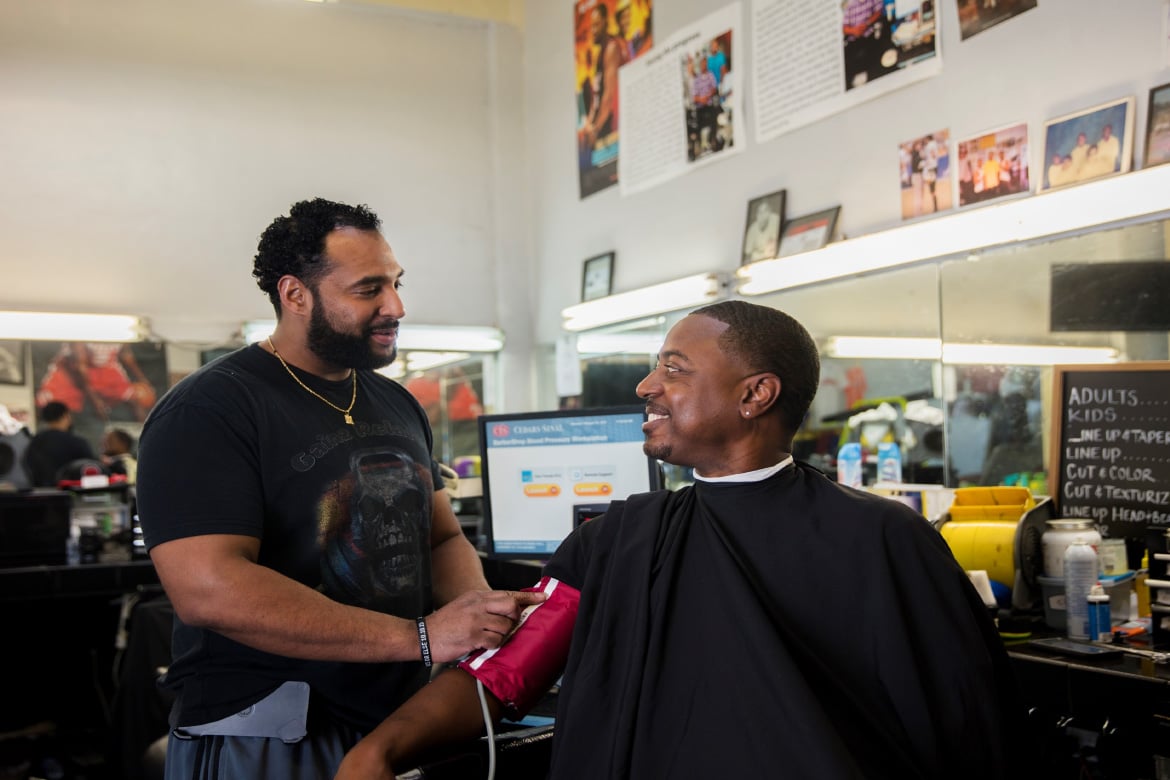Is it time for a haircut? Then there is time to cut your blood pressure too. That is the rationale behind an innovative approach to targeting the persistent problem of uncontrolled hypertension among African-American men, who are often underrepresented in intervention trials.
With 59 percent of black men living with high blood pressure, a solution is needed to improve BP control rates. To address this, researchers teamed up with Los Angeles barbers to bring BP treatment to the barbershop.
The researchers behind a study recently published in The New England Journal of Medicine developed a BP-control program for African-American men, which linked health promotion by barbers and medication therapy management.
Building on a previous trial with Dallas barbershops where barbers checked BP and promoted physician follow-up, principal investigator Ronald Victor, MD, a cardiologist and associate director of the Smidt Heart Institute at Cedars-Sinai Medical Center, included pharmacists to support BP measurement and treatment.
“The results of the Dallas trial were not as impressive as he [Dr. Victor] had hoped they would be—the blood pressure improvement was very minimal,” said C. Adair Blyler, PharmD, a clinical pharmacist at the institute. She spoke at a pre-American College of Cardiology Conference dinner in Orlando. “Our aim [in this new trial] was to develop an effective intervention which linked health promotion with barbers to pharmacists’ medication therapy.”
This study included 319 African-American men from 52 black-owned barbershops in Los Angeles. In the control group, barbers provided their patrons with a series of blood pressure-related pamphlets and promoted follow up with their usual source of medical care. In the intervention group, patrons met regularly with pharmacists at the barbershop and received blood pressure medication.
More than 60 percent of black men who met with pharmacists at their barbershop lowered their BP to less than 130/80 mm Hg. By comparison, only 12 percent of those receiving pamphlets and hypertension-related advice reached the target level.
“The idea was that everything would happen within the barbershop,” said Blyler. “Barbers were key in endorsing this program, without their support it would not have come off and it certainly would not have been successful.
Barbers trusted in community
African-American men have the highest rate of hypertension-related death of any racial, ethnic or sex group in the U.S., according to the study. They also have fewer encounters with physicians than do black women, as well as lower rates of hypertension treatment and control, which makes community outreach a necessity.
“Pharmacists made drug therapy convenient by bringing it to the barbershop,” says the study. “The intervention was tailored to black men and endorsed by barbers—trusted community members.”
“Barbers were key in endorsing this program” said Blyler. “Without their support, it would not have come off and it certainly would not have been successful.”
On average, patrons visited their barbers every two weeks and had been with the same barber or barbershop for 10 years. This loyal patronage helped facilitate hypertension management. And because most patrons in this trial lived alone, it was speculated that peer support at the barbershop helped improve health promotion.
“We’ve accomplished our goal of demonstrating effectiveness at six months,” said Blyler. “We recently finished a six-month extension study to address sustainability. Next we will look at how we can scale this up in different cities or within different health care organizations.”
As an efficacy trial, large scale implementation would require broader inclusion criteria and cost-effective business models, says the study.
“The aim was to determine the effectiveness at 6 months,” said Blyler. “We just finished the extension study. And we’re looking at how we can scale this out to different cities and different organizations.”
To help address the increase in the prevalence of hypertension, the AMA and the American Heart Association have partnered to launch Target: BP™ to improve blood pressure control. At the end of 2017, more than 1,100 physician practices and health systems nationwide have had joined Target: BP, with 310 of them recently recognized for their efforts focusing on blood pressure control within the populations they serve. Hundreds more are expected to join the initiative in 2018.
An AMA membership means you’re motivating millions to control hypertension. When the nation’s health is on the line, you can count on the AMA to be part of the solution.




